Starting your hydroponics garden can be significantly overwhelming but also greatly rewarding. There are so many different types of hydroponics, making it hard to choose from. And you might be wondering what are the 6 different types of hydroponics and which one to choose.
There are six fundamental hydroponic systems to consider for your garden: the Ebb and flow system, Deep Water Culture (DWC), Nutrient Film Technique NFT system, Wicking Systems, Drip Systems, and Aeroponics system.
There is no right or wrong answer to your hydroponics gardening journey. But below, you may find some surprising facts that could help you choose the hydroponics method that is right for you. Continue to read to learn more about the 6 types of hydroponics.
What is Hydroponics?
Hydroponics is the method of growing plants without the use of soil, and it allows plants to access the essential nutrients they need when they need them. And this consistent source of nutrients helps hydroponically grown plants to grow faster and better.
In addition, hydroponics allows you to control all aspects of the plant’s resources- light, temperature, pH, nutrient availability, and the stages of growth. With Hydroponic, you can grow your plants outside and inside.
In other words, hydroponics removes the barriers between the plant and its nutrients, providing the roots with direct access to oxygen, water, and nutrients that it requires to grow and survive.
Since you are not using soil, there is also no need for harmful pesticides or chemicals that lower the risk of plant disease or exposure to external elements.
Before starting your gardening journey, check out this article on hydroponics vs. soil gardening and the pros & cons of both.
What Are The 6 Types of Hydroponics
There are six significant types of hydroponics, and we will discuss each type and its advantages and disadvantages, and everything you need to get started.
1- The Ebb and Flow System
An ebb and flow system, also known as flood and drain hydroponics, floods your plants with nutrients on a cycle. In this hydroponics type, nutrient-rich water is stored in a central reservoir separate from the plants. The plants are contained in buckets of growing medium attached to the reservoir via tubing or in a large table with several plants and the growing medium.
With the flood and drain hydroponics, water will be flooded into the table/buckets holding the plants at predetermined times throughout the day, enabling the roots to uptake water and nutrients.
The Ebb and flow system is less common because it is less flexible to your plants’ needs. However, some gardeners prefer using it because it doesn’t continuously expose the plant roots to the nutrient solution.
The cycle of flooding depends on plants, water testing, air temperature, growth cycle, and more.
After flooding the tray, gravity drains the solution back into the reservoir to be reused. An air pump should oxygenate the water in the reservoir while waiting for the next flood cycle.
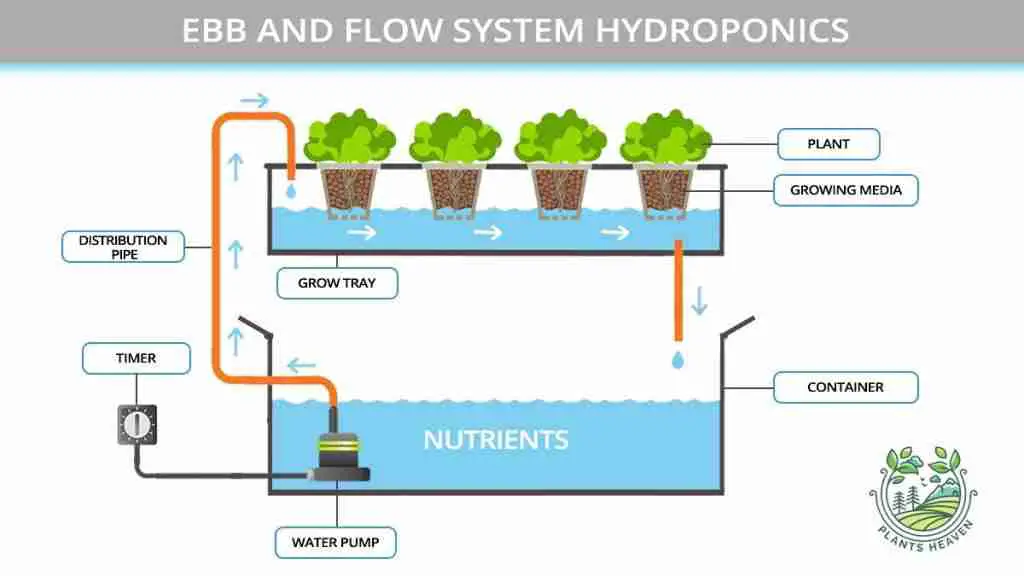
See also this detailed article on the Ebb and Flow system and everything you need to know about this interesting growing technique.
The Ebb and Flow System Hydroponics Pros and Cons
The table below contains the pros and cons of the Ebb and Flow System Hydroponics
| Material Needed | Pros | Cons |
| – Reservoir – Distilled water – Tray – Water pump – Air pump – Growing medium – Timer – Nutrient solution | – Efficient use of energy and water because the ebb and flow systems are recirculating systems – Improve growth and your yield if appropriately cycled – An ebb and flow system is also the easiest to scale. | – The Ebb and flow system may over-saturate your plants or possibly dry them out, if not balanced or timed properly – It requires consistent monitoring, particularly of environmental factors such as water pH. |
2- Deep Water Culture (DWC) Hydroponics System
Deep water culture (DWC) is generally considered the easiest of the different types of hydroponics because it contains no moving parts and requires minimal materials.
In addition, it is a great entry-level system, especially if you are a beginner. You might set it up yourself using less than $100 worth of materials, which you can find online on Amazon or at your local hardware stores.
With the Deep Water Culture (DWC) system, the plant’s roots are constantly suspended above a reservoir of nutrient-rich water. As your plants’ roots grow, they expand down further into the reservoir. You use an air pump to pump oxygen into the water, giving the roots constant access to nutrient-rich water and plenty of oxygen.
The Deep water culture is best suited towards smaller crops such as lettuce or herbs or even to grow larger varieties, including tomatoes or cucumbers, depending on how you set up your system.
With the DWC, you fill a reservoir with water and nutrient solution. And you suspend your plants over the reservoir using a net pot and growing media. The plant’s roots are submerged in the reservoir, so they have a constant supply of water and nutrients.
You need to use an air pump with an air stone to pump bubbles in the reservoir to continuously oxygenate the water and deliver necessary oxygen to the plants’ roots.
See also the top 22 pros and cons of hydroponics and everything you need to know.
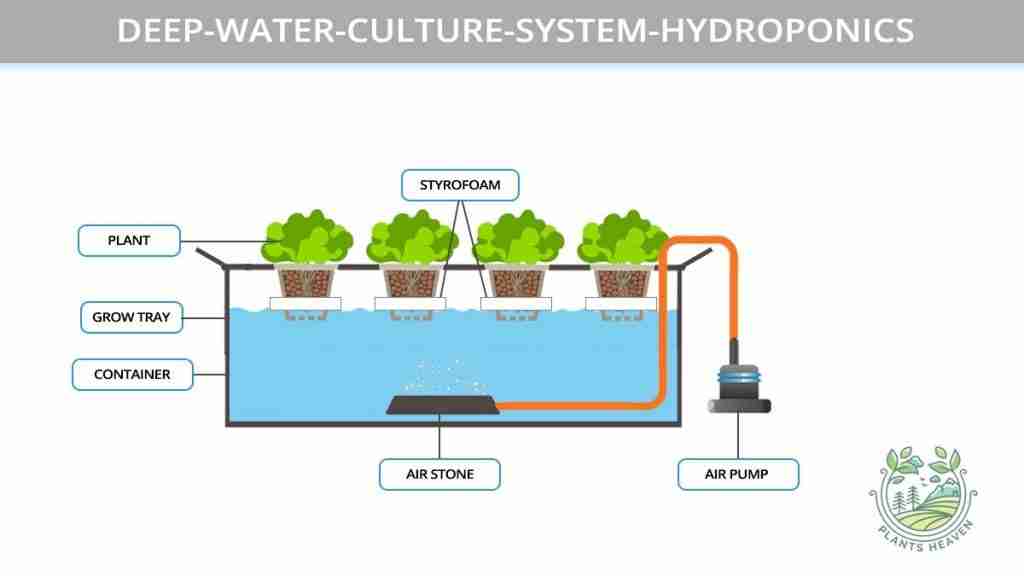
See also this detailed article on the Deep Water Culture (DWC) and everything you need to know about this hydroponics system to succeed.
Deep water culture (DWC) System Hydroponics Pros and Cons
The table below displays the Deep water culture (DWC) System Hydroponics pros and cons:
| Material Needed | Pros | Cons |
| – Reservoir – Distilled water – Growing medium – Nutrient solution – Net pots – Air pump and air stone | – The deep water culture system is Inexpensive and low-cost to maintain – Maintenance is low and only requires a reservoir, suspension system, and just primary air pumps – It uses less waste and more significant cost savings because it is a recirculating process | – If not adequately managed, your plant roots can suffocate in solution. – It doesn’t usually work for larger plants or those crops with a longer growing period. |
3- Nutrient Film Technique NFT system
The Nutrient Film Technique, or NFT, is another type of hydroponics that supplies your plants’ roots with a very shallow water stream containing all the dissolved nutrients required for plant growth.
With the NFT hydroponics system, the water and nutrient solution is contained in a large reservoir with an air pump and air stone to stay oxygenated, similar to a DWC system. However, unlike the submerged plants’ roots of a DWC, NFT system plants are grown in a nearby channel, and a water pump, set on a timer, drives water through the channel delivering a thin film of nutrients and water to the plants.
A properly designed NFT system is based on using the proper channel slope, the appropriate flow rate, and the right channel length.
See this article on the difference between NFT vs. DWC hydroponics and discover which one is better for you.
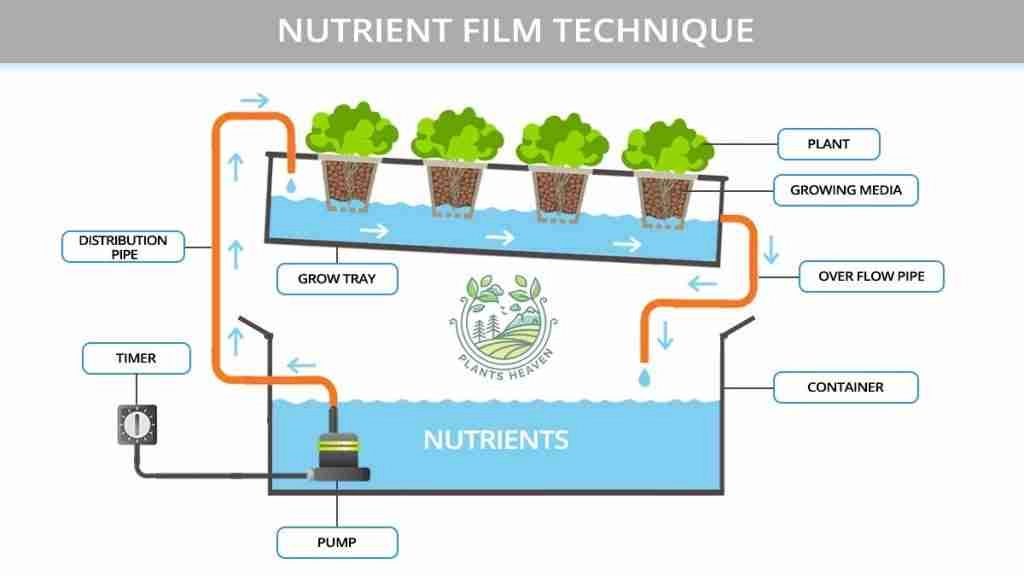
See also: the 20 most known Nutrient Film Technique (NFT) advantages and disadvantages need to be aware of
NFT System Hydroponics Pros and Cons
The table below contains the NFT system hydroponics pros and cons:
| Material Needed | Pros | Cons |
| – Reservoir – Air pump and air stone – Plant channel – Water pump – Timer – Net pots – Nutrient solution – Distilled water | – Nutrient film technique helps save water – Nutrient Film Technique system uses fewer materials than other hydroponics systems. – Easy for vertical farming – Help avoids salt build-up – Adaptable to different spaces and plant requirements – Its constant flow reduces fungal risk – NFT hydroponics has low cost and maintenance requirements – Easy to examine and investigate roots for a sign of disease. | – Nutrient Film Technique may not be beginner-friendly – NFT can be fragile and sensitive to pump failure – Plant roots can clog the channels – NFT is often considered an active system, meaning it has moving parts – Incompatible with growing larger plants with large root systems |
4- Wicking Systems
The wick system has been used for thousands of years, even before “hydroponic.” And it is the most basic type of hydroponic process and the type of system you will see in children’s science classes.
In a wick system, water and nutrients are moved to the plant’s roots using a wick, a rope, or a piece of felt. You suspend your plants in a growing medium, such as coconut coir or perlite. Under the growing container is a reservoir of water and solution. One end of the wick is in the solution, and the other end of the wick is in the growing media allowing the wick to transport the water and nutrients at the same rate required by your plants’ roots.
Wick systems are “passive hydroponics” because they don’t require air or water pumps, making them low-cost and easy to maintain, especially for beginner gardeners.
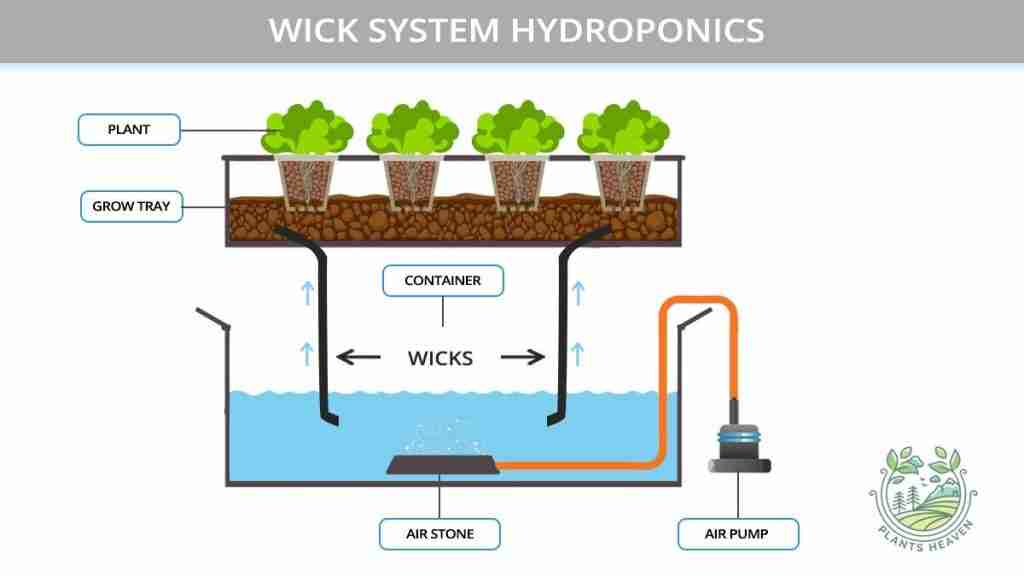
See also: Here is everything you need to know about the wick system hydroponics pros and cons.
Wick System Hydroponics Pros and Cons
The table below contains the Wick system hydroponics pros and cons:
| Material Needed | Pros | Cons |
| – Reservoir – Wick – Nutrient solutions – Growing medium – Distilled water – Monitor systems | – The wick system is excellent for smaller plants. – Once implemented, it is a simple, easy, and hands-off growing process. – It is a great option for beginners or children gardeners to introduce them to soil gardening and hydroponics. – Wick is one of the lowest-cost systems to implement compared to other hydroponics systems | – Not suitable for larger plants or extensive gardens. – Failure to set up correctly or maintain your wick hydroponics system can kill your plants. |
5- Drip Systems Hydroponics
Drip systems hydroponics are very common in commercial operations; however less common in recreational gardens because they are simple to operate on a large scale.
Drip systems are similar to NFT systems, where the plants are contained in a separate channel and suspended in net pots over a thin layer of water and nutrient solution. A pump continuously drives the water throughout the channel to promote oxygenation and nutrient uptake. The leftover solution moves back into the reservoir to be reused.
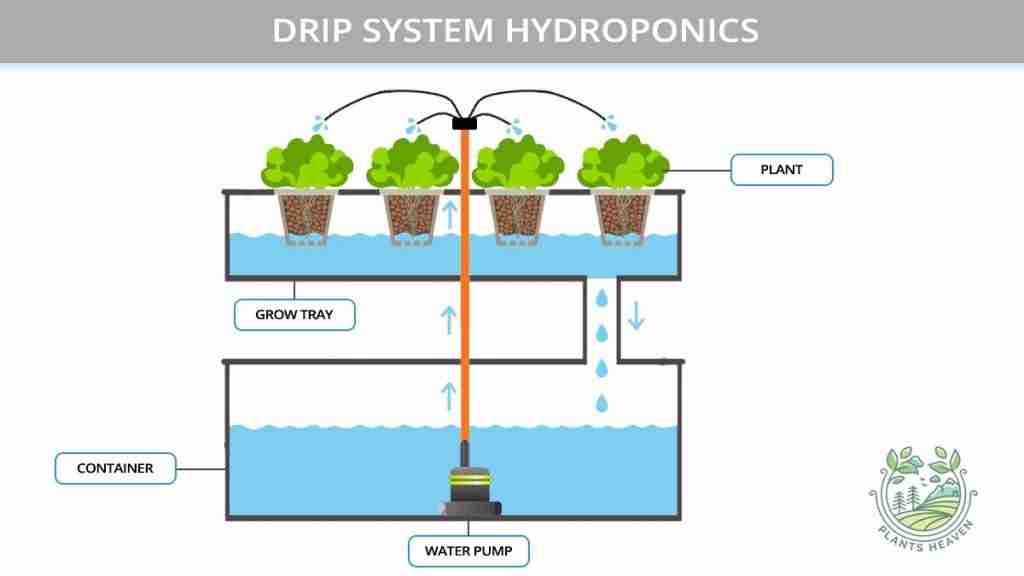
See also this detailed article on pros and cons and how you can successfully grow with the drip system hydroponics.
Drip System Hydroponics Pros and Cons
The table below shows the Drip system hydroponics pros and cons:
| Material Needed | Pros | Cons |
| – Reservoir – Timer – Water pump – Growing medium – Net pots – Channel – Distilled water – Pump system – Nutrient solution | – Offer better control over the schedule of feeding. – It is Inexpensive and highly effective, especially for commercial spaces | – Require many moving parts, which could lead to overkill, especially for home gardens. – Require you to be highly aware of monitoring pH and nutrient levels. – It doesn’t recirculate all solutions, which can often lead to a high level of waste. |
6- Aeroponics System
Aeroponic systems are usually more expensive and the most high-tech, and one of the most effective systems. In an aeroponic system, you suspend your plants and their roots in the air. The reservoir has misters, spraying a fine spray over the plant roots.
Some gardeners will use a continuous, fine mist, while others will mist on a cycle that allows the roots to have nutrients without oversaturation or submersion continuously. It also naturally enables the roots to have greater exposure to oxygen, which is critical for growth and development.
A 2021 study found that with aeroponic systems, you can adjust the irrigation according to the plants’ demands.
Furthermore, the researchers observed that nitrate supply to the plants could be minimized in aeroponics without significantly reducing the plant performances due to high nitrate uptake.
And most importantly, aeroponic systems help estimate the exact amount of water transpired by the plant at any given time.
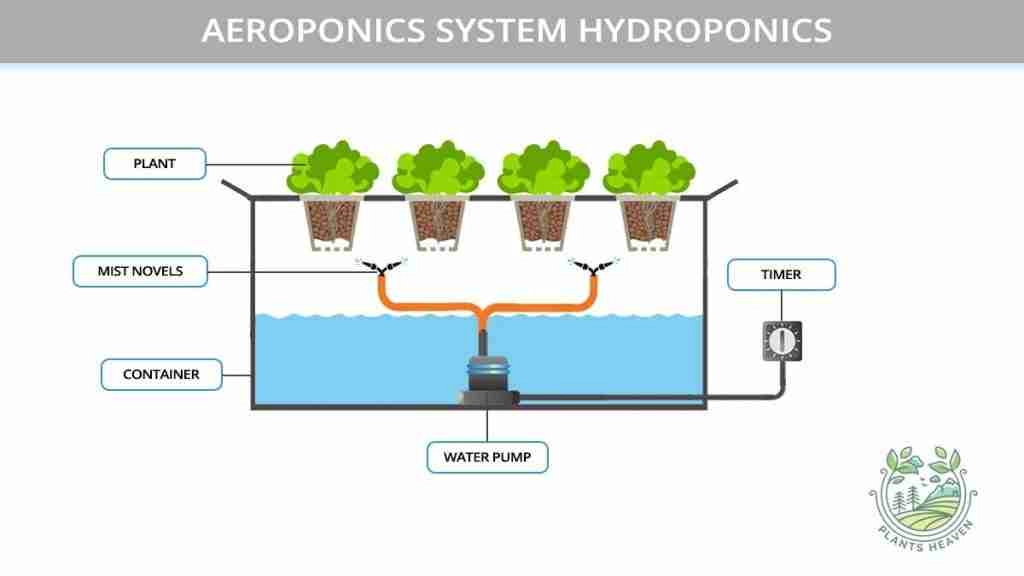
See also: Aeroponics and Hydroponics: Which one should you start?
Aeroponics System Hydroponics Pros and Cons
The table below contains the Aeroponics system hydroponics pros and cons:
| Material Needed | Pros | Cons |
| – Reservoir – Air pump – Suspension pots – Timer – Mist nozzles – Distilled water – Nutrient solution | – Expose your plants’ roots to more oxygen. – Offer less possibility of oversaturation or under-saturation of your plants’ roots. – Generally, the easiest to maintain and monitor. | – It can be an expensive system. – A mist nozzle or pump failure may have terrible effects on your plants. |
Wrapping Up
Choosing the types of hydroponics that work best for you is critical to your hydroponic gardening success. There are several variables to consider when choosing your hydroponic system. And it is essential to research the perfect hydroponics system for your garden, from price to plants to waste.
If you are looking for low-cost and relatively low-maintenance, especially if you are new to growing plants, consider a Wicking system, Deep Water Culture (DWC), or Nutrient Film Technique NFT system.
And, if you are a more advanced gardener looking for greater yield with stronger monitoring processes, consider the Ebb and Flow or Aeroponics system.

